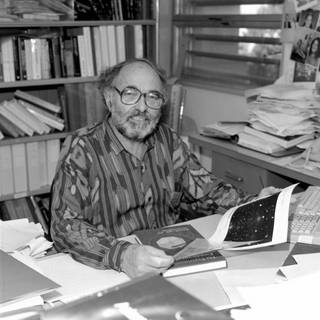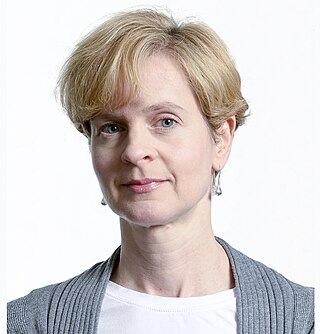Related Research Articles

Leon Max Lederman was an American experimental physicist who received the Nobel Prize in Physics in 1988, along with Melvin Schwartz and Jack Steinberger, for research on neutrinos. He also received the Wolf Prize in Physics in 1982, along with Martin Lewis Perl, for research on quarks and leptons. Lederman was director emeritus of Fermi National Accelerator Laboratory (Fermilab) in Batavia, Illinois. He founded the Illinois Mathematics and Science Academy, in Aurora, Illinois in 1986, where he was resident scholar emeritus from 2012 until his death in 2018.

Murray Gell-Mann was an American physicist who played a preeminent role in the development of the theory of elementary particles. Gell-Mann introduced the concept of quarks as the fundamental building blocks of the strongly interacting particles, and the renormalization group as a foundational element of quantum field theory and statistical mechanics. He played key roles in developing the concept of chirality in the theory of the weak interactions and spontaneous chiral symmetry breaking in the strong interactions, which controls the physics of the light mesons. In the 1970s he was a co-inventor of quantum chromodynamics (QCD) which explains the confinement of quarks in mesons and baryons and forms a large part of the Standard Model of elementary particles and forces.

In physics, a subatomic particle is a particle smaller than an atom. According to the Standard Model of particle physics, a subatomic particle can be either a composite particle, which is composed of other particles, or an elementary particle, which is not composed of other particles. Particle physics and nuclear physics study these particles and how they interact. Most force carrying particles like photons or gluons are called bosons and, although they have discrete quanta of energy, do not have rest mass or discrete diameters and are unlike the former particles that have rest mass and cannot overlap or combine which are called fermions.

Peter Ware Higgs is a British theoretical physicist, Emeritus Professor at the University of Edinburgh, and Nobel Prize laureate for his work on the mass of subatomic particles.
Francis Edwin Close, is a particle physicist who is Emeritus Professor of Physics at the University of Oxford and a Fellow of Exeter College, Oxford.

Jonathan Richard "John" Ellis is a British-Swiss theoretical physicist.

Gerson Goldhaber was a German-born American particle physicist and astrophysicist. He was one of the discoverers of the J/ψ meson which confirmed the existence of the charm quark. He worked at Lawrence Berkeley National Laboratory with the Supernova Cosmology Project, and was a professor of physics at the University of California, Berkeley as well as a professor at Berkeley's graduate school in astrophysics.

Luciano Maiani is a Sammarinese physicist best known for his prediction of the charm quark with Sheldon Glashow and John Iliopoulos.

Mary Katharine Gaillard is an American theoretical physicist. Her focus is on particle physics. She is a professor of the graduate school at the University of California, Berkeley, a member of the Berkeley Center for Theoretical Physics, and visiting scientist at the Lawrence Berkeley National Laboratory. She was Berkeley's first tenured female physicist.
Hafeez Hoorani or Hafeez-ur-Rehman Hoorani or Hafeez R. Hoorani is a Pakistani particle physicist, with a specialisation in accelerator physics, and a research scientist at the CERN. Hoorani is working at the National Center for Physics, with research focus in elementary particle physics and high energy physics. Until the end of 2013, he served as scientific director of International Centre for Synchrotron-Light for Experimental Science Applications in the Middle East (SESAME) and is now research associate at the National Center for Nuclear Physics, Islamabad.

Bikash Sinha was an Indian physicist who was active in the fields of nuclear physics and high energy physics. Sinha was the director of the Saha Institute of Nuclear Physics and Variable Energy Cyclotron Centre and the chairman of the Board of Governors of the National Institute of Technology, Durgapur in June 2005. He was also a member of scientific advisory board to the Prime Minister of India.

Stavros Katsanevas was a Greek-French astrophysicist who was director of the European Gravitational Observatory, professor at the Université Paris Cité, former director of the AstroParticle and Cosmology (APC) laboratory and former chairman of the Astroparticle Physics European Consortium (APPEC). In 2000, he received for his work on supersymmetry the Physics Prize from the Academy of Athens. In 2011, he was awarded the Ordre National du Merite. He was an ordinary member of Academy of Europe, Earth and Cosmic Sciences since 2019.
Anthony William (Tony) Thomas is an Australian physicist, Professor of Physics at the University of Adelaide since 1984 and Elder Professor of Physics since 1990.
Peter Ignaz Paul Kalmus, is a British particle physicist, and emeritus professor of physics at Queen Mary, University of London.

The idea that matter consists of smaller particles and that there exists a limited number of sorts of primary, smallest particles in nature has existed in natural philosophy at least since the 6th century BC. Such ideas gained physical credibility beginning in the 19th century, but the concept of "elementary particle" underwent some changes in its meaning: notably, modern physics no longer deems elementary particles indestructible. Even elementary particles can decay or collide destructively; they can cease to exist and create (other) particles in result.
Kenneth Arthur Bloom is an American particle physicist. He is a full professor at the University of Nebraska–Lincoln and an Elected Fellow of the American Physical Society.

Yaşar Önel is a Turkish-born physicist who holds Swiss and American citizenship. He received his Ph.D. in Physics from London University in 1975. He worked at the Queen Mary University of London in the United Kingdom, and Neuchatel and Geneva Universities in Switzerland before joining the University of Texas at Austin in 1986. Then, he moved to the University of Iowa in 1988. He is a tenured faculty professor. of Physics at the University of Iowa in Iowa City, IA, USA.

Wendy Taylor is an Experimental Particle Physicist at York University and a former Canada Research Chair. She is the lead for York University's ATLAS experiment group at CERN.

Christine Angela Aidala is an American high-energy nuclear physicist, Alfred P. Sloan Research Fellow and Associate Professor of Physics at the University of Michigan. She studies nucleon structure and parton dynamics in quantum chromodynamics.
Geoffrey Hall, is a British particle physicist, currently Professor of Physics at Imperial College London. He is best known for developing radiation and particle detectors and other electronic instruments for use in particle physics experiments, notably the CMS detector in CERN's Large Hadron Collider.
References
- 1 2 3 4 5 6 7 "Allen Sessoms's Biography". The HistoryMakers. Retrieved 2020-10-19.
- 1 2 3 4 "Allen Lee Sessoms - Physicist of the African Diaspora". www.math.buffalo.edu. Retrieved 2020-10-19.
- ↑ DeBonis, Mike (December 20, 2012). "Down goes Allen Sessoms". Washington Post. Retrieved October 19, 2020.
- ↑ "UDC President Elected Fellow of the Prestigious American Physical Society". University of the District of Columbia. December 2, 2008. Archived from the original on March 9, 2009.